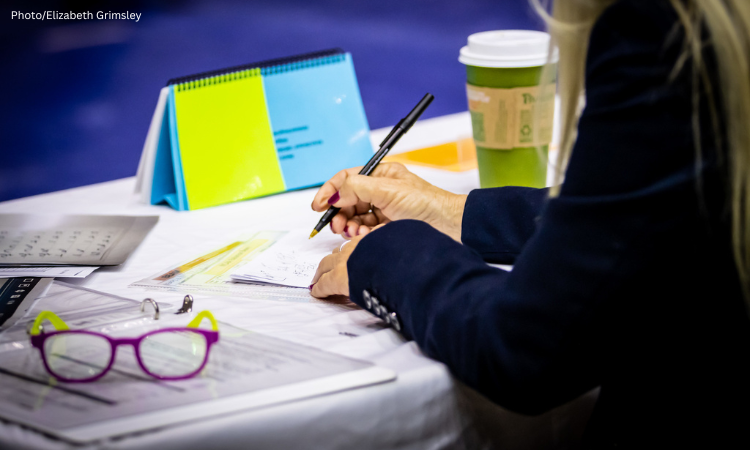Week 6 of NCAA Gymnastics was jam-packed with impressive performances from gymnasts across the country, but it seems like everyone is talking about one thing: overscoring. Athletes, coaches, judges, and fans have accepted a certain level of inaccuracy in scoring, but understandably are even more upset when these errors seem to benefit one team over another. The outrage around overscoring reached a boiling point when Chloi Clark of Florida scored a perfect 9.95 from one judge on her Yurchenko full with a clearly visible large hop on the landing. This week, we will be breaking down her routine and others that were requested, with the goal of educating the fans, as well as hopefully inspiring change in the judging community to find solutions to improve the quality and consistency of judging across the country.
Vault
Chloi Clark (Florida)
Yurchenko full, 9.950 start value
Large hop backward (-0.200)
Clark performed a powerful, beautifully executed Yurchenko full, with the only deduction that matters being her hop. It’s unclear whether Judge 2 a) didn’t see the hop, b) flashed an incorrect start value and only took half a tenth on the landing, c) accidentally flashed the start value as the score, or d) something else. Per the NCAA rules, the head judge can only call a conference for an impossible start value but not for an impossible score, and since they were in range, there was little that Judge 1 could do without breaking the NCAA Rules.
Panel Score: 9.750/9.950
My Score: 9.750
Anaya Smith (Arizona State)
Yurchenko one and a half, 10.000 start value
Bent arms (-0.050)
Shoulder angle (-0.050)
Leg form (-0.050)
Leg separation (-0.050)
This vault had great height, distance, and landing control, but it did have some form issues on the table and in the air. It’s unlikely the panel caught all three of the form breaks on the table, so 9.850 is a very reasonable score for this vault.
Panel Score: 9.850/9.850
My Score: 9.800
Luisa Blanco (Alabama)
Yurchenko one and a half, 10.000 start value
Shoulder angle (-0.050)
Distance (-0.050)
Panel Score: 9.900/9.950
My Score: 9.900
Blanco completed an excellent vault with a beautifully stuck landing, but the shoulder angle likely cut her distance short as well. This is a great example of the cause and effect relationship of deductions on vault.
Bars
Mara Titarsolej (LIU)
This routine 100% could have been a 10.000. I honestly do not see any deductions. Her handstands and turns are all aligned, her release combination is beautiful, and her dismount is elegant and controlled. Check it out for yourself and let me know if you see anything I should have taken.
Panel Score: 9.900/10.000
My Score: 10.000
Audrey Davis (Oklahoma)
Short cast handstand x2 (-0.050 each)
Legs separation (-0.050)
Davis does a great job making these short handstands look much closer to vertical than they are in reality. The trick is to look at the alignment of her shoulders and her wrists. Her shoulders are behind the bar, rather than over her wrists as they would be in vertical. By opening her shoulders and chest position, it gives the illusion that she is more on top of the bar than reality. In her dismount, a small amount of knee separation is permissible for safety reasons, but her legs are staggered and separated, and should have joined together as she opened her body to land.
Panel Score: 9.950/9.950
My Score: 9.850
Beam
Helen Hu (Missouri)
Balance error with supplemental support (-0.300)
Body position (-0.050)
Underrotation (-0.050)
Step forward (-0.100)
Hu has a beautifully original routine that usually scores 9.9-plus, but this week was not her week. Grabbing the beam to avoid a fall is a flat three-tenth deduction, and her dismount was slightly underpowered as well.
Panel Score: 9.700/9.650
My Score: 9.500
Abby Heiskell (Michigan)
Broken connection and/or rhythm deduction (-0.050)
Leg position, cat leap (-0.050)
Balance error (-0.100 to -0.150)
Bent arms (-0.050)
Balance error (-0.050)
Balance error (-0.050)
Small hop on landing (-0.050)
I realize I’m being a little harsh in this evaluation, but every single one of these deductions is justifiable. Heiskell is slightly off to her right when she lands her acro series, and you can see her left shoulder drop out of her full turn. Even if you missed these tiny balance errors, the long pause in her mixed acro series would incur a rhythm deduction or could break the series completely. She also hops back and slightly to her right on the landing. If I’m being harsh (but still accurate), she has a 9.900 SV with a 9.500 score, and if I’m being “college nice,” it’s a 10.000 SV with a 9.650 score.
Panel Score: 9.900/9.850
My Score: 9.650
Floor
Selena Harris (UCLA)
Leg separation (-0.050)
Flexed feet (-0.050)
Body posture on landing (-0.050)
Body posture on landing (-0.050)
Leg form (-0.050)
Harris’ stuck landings this week were impressive and left many fans wondering about her score. However, despite the sticks, her chest was low on both her double flipping saltos. Her leap pass was beautifully executed though, and I’m definitely a stickler for leap passes.
Panel Score: 9.950/9.800
My Score: 9.750
Lynnzee Brown (Denver)
Step on landing (-0.100)
Leg separation (-0.050)
Bent leg on switch leap half (-0.050)
Hop forward (-0.100)
Brown’s first floor routine back after her injury last season did not disappoint! Her landings need a little more control, which is understandable given her recent return to competition. Her position is a bit questionable on her switch ring leap, but I’ll give it to her.
Panel: 9.850/9.900; -0.100 for OOB for 9.775
My Score: 9.700; -0.100 for OOB for 9.600
Hopefully this helps you understand why some routines were scored lower than you may have expected during Week 6. Usually the routines that appear “underscored” are the ones that are properly evaluated. These inconsistencies can be frustrating and confusing, especially if the score is drastically different for an athlete that may have been overscored in the past. But don’t worry, if your favorite athlete was “underscored” or your least favorite team was “overscored” this week, there’s always next week’s meets to bring another round of scores to even things out.
READ THIS NEXT: Judge’s Inquiry: Explaining Why Some Routines Don’t Start From a 10
Article by Rhiannon Franck
Rhiannon Franck is a former national-rated NAWGJ women’s gymnastics judge with over 15 years of USAG judging experience and nine seasons judging NCAA gymnastics. Outside of gymnastics, Franck works at a university as a nursing professor and loves to travel. You can follow her on Instagram and Twitter.
Like what you see? Consider donating to support our efforts throughout the year!



Excellent break down! Thank you for sharing your knowledge Rhiannon!
I personally thought Titarsolej finished the full pirouette a little past the 10*. I might’ve taken -0.05 there.
Pirouettes have a 20-degree grace zone while handstands have to be within 10 degrees. That’s something we questioned at first too!
man. I keep forgetting they’re different. I’m never going to remember everything. What’s funny is I know the healy technique stuff like it’s the lyrics to baby Shark, and one does the one arm spins past HS anymore. I’m going to have to study more if I’m ever going to pass these practice judging test things.
Miss Franck,
I really want to thank you for the work and information sharing you do for those of us attempting to understand this crazy sport of ours from a technical judging level. I was a gymnast for 19 years and have coached and choreographed off and on for the last 12 years. However, now I am starting to do the work to become a judge.
Studying the code and applying the deductions to routines I see online is confusing at times…at least when I get feedback in comment sections telling me “The judges don’t deduct for that”, or “Her feet didn’t move! She doesn’t have any landing deductions! Duh!”, or “She does way more difficulty so that makes up for her looking drowsy/bored in between tumbling passes.”
Anyway, I was in the middle of reading your breakdowns and saw the comment about you being a stickler for leap pass rotation, and I felt really validated in that moment. I get so crazy when I see these tour jete 2/3 + straddle jump 3/4, and no deductions are taken. It’s not like the gymnasts _can’t_ do precise dance passes, right? They just aren’t getting deductions so the leaps get less and less precise.
I’m rambling. Thanks again!